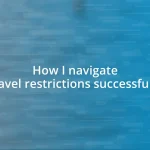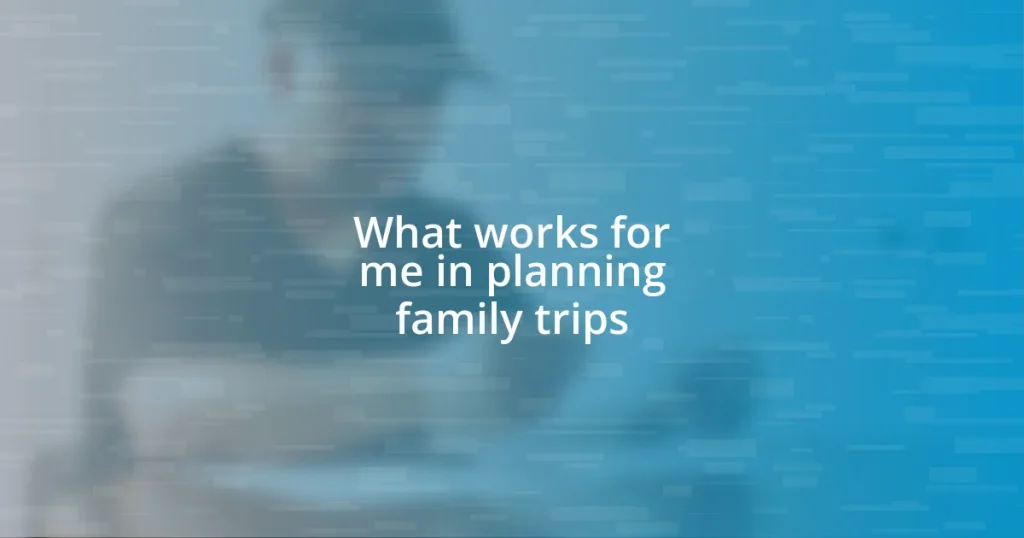Key takeaways:
- Setting clear trip goals and involving family preferences enhances the overall experience and prioritizes meaningful activities.
- A flexible itinerary fosters spontaneity, allowing for unexpected, memorable moments during travel.
- Packing thoughtfully, scheduling downtime, and leveraging technology can significantly improve the ease and enjoyment of family trips.

Planning family trip goals
When I plan a family trip, I always start by setting clear goals that align with what everyone wants to experience. For instance, during our last vacation, my goal was to find a balance between relaxation for the adults and adventure for the kids. It was such a rewarding experience to see everyone excited about the activities we chose together!
I often ask my family what they hope to gain from our trips. Do the kids want to explore nature, or are they more into visiting historical sites? This simple question opens up a treasure trove of ideas and helps prioritize what we should include. Last summer, when my daughter expressed her wish to see wildlife, we incorporated a day at a national park that turned out to be the highlight of our trip!
Focusing on goals also means embracing spontaneity when it fits into our plans. I learned this on a road trip when we stumbled upon a local festival. Instead of sticking rigidly to our itinerary, we decided to join in the fun! That day taught me that while planning is essential, sometimes the best memories come from unexpected moments.

Evaluating family preferences
When diving into family preferences, I find it essential to have open conversations. Sneaking in fun family meetings over dinner can yield amazing insights. Last winter, I asked my kids what kind of vacation they dreamed of. Seeing their eyes light up when they talked about a beach getaway reminded me just how much their happiness shapes our trips.
As I evaluate preferences, I pay close attention to the age range and interests of my family members. I recall a past trip where I underestimated my son’s thrill-seeking attitude. A visit to an amusement park turned into an adventure-filled day of roller coasters, much to his delight. Balancing preferences can be tricky, but I believe it’s all about finding activities that appeal to everyone, even if it means making some compromises.
It’s also helpful to look back on previous trips for clues. Reflecting on what each family member enjoyed—or didn’t—can steer future planning. I remember our camping trip when my partner and I realized we needed more comfort than just sleeping bags! This led to the decision to rent a cabin for our next adventure, where everyone could relax and my son could still explore the outdoors. Evaluating preferences can really transform our travel experiences!
| Family Member | Preferences |
|---|---|
| Kids | Adventure and exploration |
| Adults | Relaxation and cultural experiences |
| Teenagers | Social activities and entertainment |

Budgeting for family adventures
When it comes to budgeting for family adventures, I’ve learned that a strategic approach can help keep things exciting without breaking the bank. Setting a realistic budget was transformative for us—it gave me clarity on what we could afford. For instance, I remember a trip to a popular amusement park where we all agreed to stash away some money for treats, but I also discovered the joy of bring-your-own snack options to save for our dinner outing.
To better manage our expenses and prioritize experiences, I like to break down our budget into specific categories, such as travel, lodging, food, and activities. Here’s how I typically allocate our funds:
- Travel: Consider vehicle costs, gas, or flights. For a memorable road trip, we embraced the open highway and made excellent memories along the way.
- Lodging: We often weigh the pros and cons of hotels versus vacation rentals. A cozy rental might feel like home.
- Food: Eating out can add up, so I plan for some home-cooked meals, making sure we can connect with local cuisine as well.
- Activities: I like to balance splurges with free or low-cost activities like hiking trails or beach days, which often turn out to be the most cherished experiences.
Keeping everyone in the loop about the budget not only fosters accountability but also allows my family to feel involved in the planning. Last summer, I shared our limited budget for a beach trip, and it was heartwarming when my kids suggested affordable ice cream outings instead of expensive theme parks, showcasing their mature understanding of financial stewardship.

Choosing the right destination
When it comes to choosing the right destination, I often start by considering what my family is in the mood for at that moment. Are we longing for a peaceful beach escape, or is there an itch for an adventurous mountain hike? I remember planning a long weekend at the coast, and the mere thought of my kids building sandcastles energized me. They’d been so busy with school, and I could almost feel the excitement bubbling in the air as we got closer to the trip.
Another factor I weigh heavily is how far we want to travel. Driving for hours versus a quick flight can make a night-and-day difference in our experience. I recall one road trip where we underestimated travel time, turning what should have been a relaxing start into a frenzied dash. It taught me that sometimes being close to home can lead us to hidden gems we’d never explore otherwise, like that charming little town we recently stumbled upon just a couple of hours away.
I also love to incorporate the element of spontaneity in our destination choices. Often, I find that some of our best family memories stem from unplanned adventures. Just last fall, we decided to visit a pumpkin patch on a whim, which unexpectedly led us to an amazing local festival. The joy on my children’s faces, seeing them engage with the community and its culture, was priceless. Isn’t it fascinating how the unplanned can sometimes feel more refreshing than the meticulously crafted itineraries?

Creating a flexible itinerary
Creating a flexible itinerary has been a game changer for our family trips. I’ll never forget when we went to a national park and had a rough outline for each day. However, a sudden rainstorm turned our hiking plans upside down. Instead of moaning about the weather, we embraced the chance to check out a nearby visitor center. It turned out to be a memorable experience, discovering local wildlife through interactive exhibits. Isn’t it funny how a little curveball can lead to unexpected joy?
For me, having key activities planned but leaving room for spontaneous explorations has proven to be a winning strategy. On one trip to a vibrant city, we had tickets for a museum and planned to indulge in a fancy dinner afterward. But that day, as we strolled through a buzzing market, the delicious aroma of street food drew us in. We ended up sharing authentic local dishes instead, laughing and chatting with vendors, which transformed our evening into a delightful cultural immersion. Doesn’t that spontaneity make the journey feel alive?
I’ve also learned the importance of checking in with the family throughout the trip. Sometimes, after a long day of sightseeing, I’ll ask my kids what they’d like to do next. On a recent road trip, they opted to skip an overly ambitious itinerary in favor of a campfire night at our campsite. We roasted marshmallows, told stories, and felt those perfect moments of connection. So, when crafting your own itinerary, how can you create not just a plan, but also space for these treasured experiences?

Engaging activities for all ages
Engaging activities for all ages can make family trips feel truly special. I remember a particular beach vacation where we rented paddleboards. Watching my children laugh and tumble into the water was a highlight, but what truly surprised me was how my parents, who typically shy away from physical activities, joined in too. It turned into a fun family competition—who could stay upright the longest? It was a delightful mix of generations bonding over a shared laugh.
Incorporating creative activities can also spark joy for everyone. On another trip to a picturesque town, we stumbled upon an art workshop offering pottery classes. Initially, my kids were reluctant, but once they started molding the clay, their giggles filled the room. I participated alongside them, which led to some sticky fingers and a few accidental splats. The shared laughter and collective frustration over our less-than-perfect creations resulted in memories that we cherish today. Isn’t it amazing how sometimes the messy moments can bring more joy than any polished experience?
I’ve found that outdoor scavenger hunts while exploring new places encourage everyone to engage actively. On a recent hiking trip, I devised a little game where we had to find specific leaves and rocks. The excitement in my kids’ voices as they crossed off each item was contagious. Plus, it kept us moving and curious, transforming what could have been a simple walk into an adventurous quest. So, how can you incorporate such simple yet effective activities into your next family trip?

Tips for smooth family travel
Tips for smooth family travel
One vital tip I’ve gathered over time is to pack thoughtfully for the kids. I’ve experienced the chaos of forgotten comfort items—like my son’s beloved stuffed animal. After a stressful night without it during a trip, I learned my lesson! Now, I make a checklist and always include their favorites, which significantly boosts everyone’s mood while traveling. What small item can make a world of difference for your kids on your next adventure?
Scheduling downtime is another essential aspect I’ve picked up. Family trips can get a bit overwhelming with all the excitement. I remember one holiday where we jam-packed our days with activities. By mid-week, I could see exhaustion creeping in, and the kids were less enthusiastic. That experience taught me the value of unstructured time. Allowing for breaks to relax, recharge, or even just play at a park made a world of difference. How do you prioritize relaxation amidst all the fun?
Lastly, embracing technology can effortlessly smooth your travel journey. I tend to download engaging games or audiobooks for the kids before lengthy drives. During a particularly long trek last summer, this strategy worked wonders! Not only did it keep them entertained, but it also sparked conversations about the stories we were listening to. Did you know that combining leisurely tech time with travel can enhance family bonding? It’s as if technology transforms into a storytelling companion, helping us connect and unwind together.
















